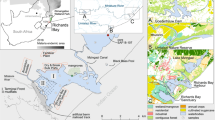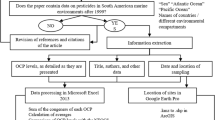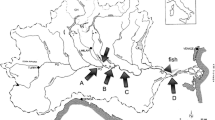Abstract
To better understand the past and present impact of contaminants of emerging concern (CECs) in coastal and marine ecosystems, archived samples were analyzed for a broad suite of analytes, including pharmaceuticals and personal care products (PPCPs), flame retardants (including PBDEs), perfluorinated compounds (PFCs), and current-use pesticides. Surface sediment, mussels (Mytilus spp.) and sediment core samples collected from the California (USA) coast were obtained from environmental specimen banks. Selected CECs were detected in recent surface sediments, with nonylphenol (4-NP), its mono- and di-ethoxylates (NP1EO and NP2EO), triclocarban, and pyrethroid insecticides in the greatest abundance. Alkylphenols, triclocarban, and triclosan were present in sediment core segments from the 1970s, as well as in Mytilus tissue collected during the 1990s. Increasing concentrations of some CECs (e.g., miconazole, triclosan) were observed in the surface layers (ca. 2007) of a sediment core, in contrast to peak concentrations of 4-NP and triclocarban corresponding to input during the 1970s, and an apparent peak input for PBDEs during the 1990s. These results suggest that chemicals sometimes referred to as “emerging” (e.g., alkylphenols, triclocarban) have been present in the aquatic environment for several decades and are decreasing in concentration, whereas others (e.g., miconazole, triclosan) are increasing.





Similar content being viewed by others
References
Ahn JH, Grant SB, Surbeck CQ, Digiacomo PM, Nezlin NP, Jiang S (2005) Coastal water quality impact of stormwater runoff from an urban watershed in southern California. Environ Sci Technol 39:5940–5953
Alvarez DA, Maruya KA, Dodder NG, Lao W, Furlong ET, Smalling KL (2013) Occurrence of contaminants of emerging concern along the California coast (2009-10) using passive sampling devices Mar Pollut Bull doi:10.1016/j.marpolbul.2013.04.022
Ankley GT, Miller DH, Jensen KM, Villeneuve DL, Martinović D (2008) Relationship of plasma sex steroid concentrations in female fathead minnows to reproductive success and population status. Aquat Toxicol 88:69–74
Bouzas A, Aguado D, Martí N, Pastor JM, Herráez R, Campins P (2010) Alkylphenols and polycyclic aromatic hydrocarbons in eastern Mediterranean Spanish coastal marine bivalves Environ Monit Assess doi:10.1007/s10661-010-1574-5
Bradley PW, Wan Y, Jones PD, Wiseman S, Chang H, Lam MH, Long DT, Giesy JP (2011) PBDEs and methoxylated analogues in sediment cores from two Michigan, USA, inland lakes. Environ Toxicol Chem 30(6):1236–1242
Chen SJ, Luo XJ, Lin Z, Luo Y, Li KC, Peng XZ, Mai BX, Ran Y, Zeng EY (2007) Time trends of polybrominated diphenyl ethers in sediment cores from the Pearl River Estuary, South China. Environ Sci Technol 41:5595–5600
Diehl J, Johnson SE, Xia K, West A, Tomanek L (2012) The distribution of 4-nonylphenol in marine organisms of North American Pacific Coast estuaries. Chemosphere 87:490–497
Dodder NG, Maruya KA, Lauenstein GG, Ramirez J, Ritter KJ, Schiff KC (2012) Distribution and sources of polybrominated diphenyl ethers in the Southern California Bight. Environ Toxicol Chem 31:2239–2245
Dodder NG, Maruya KA, Ferguson PL, Grace R, Klosterhaus S, La Guardia MJ, Lauenstein GG, Ramirez J (2013) Occurrence of contaminants of emerging concern in mussels (Mytilus spp.) along the California coast and the influence of land use, storm water discharge, and treated wastewater effluent. Mar Pollut Bull doi:10.1016/j.marpolbul.2013.06.041
Drury B, Scott J, Rosi-Marshall EJ, Kelly JJ (2013) Triclosan exposure increases triclosan resistance and influences taxonomic composition of benthic bacterial communities. Environ Sci Technol 47:8923–8930
Environment Canada (2012) Chemicals Management Plan Environmental Monitoring and Surveillance Program. http://www.ec.gc.ca/indicateurs-indicators/default.asp?lang=en&n = 0970C75C-1. Accessed 23 October 2013
Ferguson PL, Brownawell BJ (2003) Degradation of nonylphenol ethoxylates in estuarine sediment under aerobic and anaerobic conditions. Environ Toxicol Chem 22(6):1189–1199
Ferguson PL, Bopp RF, Chillrud SN, Aller RC, Brownawell BJ (2003) Biogeochemistry of nonylphenol ethoxylates in urban estuarine sediments. Environ Sci Technol 37:3499–3506
Fernandez LA, Lao W, Maruya KA, White C, Burgess RM (2012) Passive sampling to measure background dissolved persistent organic pollutant concentrations in the water column of the Palos Verdes Shelf Superfund site. Environ Sci Technol 46:11937–11947
Fernández-Sanjuan M, Faria M, Lacorte S, Barata C (2013) Bioaccumulation and effects of perfluorinated compounds (PFCs) in zebra mussels (Dreissena polymorpha). Environ Sci Pollut Res 20:2661–2669
Halden RU, Paull DH (2005) Co-occurrence of triclocarban and triclosan in U.S. water resources. Environ Sci Technol 39:1420–1426
Isobe T, Nishiyama H, Nakashima A, Takada H (2001) Distribution and behavior of nonylphenol, octylphenol, and nonylphenol monoethoxylate in Tokyo metropolitan area: their association with aquatic particles and sedimentary distributions. Environ Sci Technol 35:1041–1049
Kajiwara N, Ueno D, Takahashi A, Baba N, Tanabe S (2004) Polybrominated diphenyl ethers and organochlorines in archived northern fur seal samples from the Pacific coast of Japan, 1972-1998. Environ Sci Technol 38:3804–3809
Keith TL, Snyder SA, Nayler CG, Staples CA, Summer C, Kannan K, Giesy JP (2001) Identification and quantitation of nonylphenol ethoxylates and nonylphenol in fish tissue from Michigan. Environ Sci Technol 35:10–13
Lao W, Tsukada D, Greenstein DJ, Bay SM, Maruya KA (2010) Analysis, occurrence and toxic potential of pyrethroids and fipronil in sediments from an urban estuary. Environ Toxicol Chem 29:834–851
Lao W, Tiefenthaler L, Greenstein DJ, Maruya KA, Bay SM, Ritter K, Schiff K (2012) Pyrethroids in southern California coastal sediments. Environ Toxicol Chem 31:1649–1656
Lauenstein GG, Cantillo AY, Kokkinakis S, Frew S, Jobling HJ, Fay RR (1997) Mussel Watch Project site descriptions, through 1997. NOAA Technical Memorandum NOS ORCA 112
Lauenstein GG, Cantillo AY (1998) Sampling and analytical methods of the National Status and Trends Program Mussel Watch Project: 1993-1996 update. NOAA Technical Memorandum NOS ORCA 130
Law RJ, Allchin CR, de Boer J, Covaci A, Herzke D, Lepom P, Morris S, Tronczynski J, de Wit CA (2006) Levels and trends of brominated flame retardants in the European environment. Chemosphere 64:187–208
Maruya KA, Schiff K (2009) The extent and magnitude of sediment contamination in the Southern California Bight. Geol Soc Am Spec Pap 454:399–412
Maruya KA, Vidal-Dorsch D, Bay SM, Kwon JW, Xia K, Armbrust KL (2012) Organic contaminants of emerging concern in sediments and flatfish collected near outfalls discharging treated wastewater effluent to the Southern California Bight. Environ Toxicol Chem 31:2683–2688
Maruya KA, Dodder NG, Schaffner RA, Weisberg SB, Gregorio D, Klosterhaus S, Alvarez DA, Furlong ET, Kimbrough KL, Lauenstein GG, Christensen JD (2013a) Refocusing Mussel Watch on contaminants of emerging concern (CECs): the California pilot study (2009-10). Mar Pollut Bull. doi:10.1016/j.marpolbul.2013.04.027
Maruya KA, Schlenk D, Anderson PD, Drewes JE, Denslow ND, Olivieri AW, Scott GI, Snyder SA (2013b) An adaptive, comprehensive monitoring strategy for chemicals of emerging concern (CECs) in California’s aquatic ecosystems. Integr Environ Assess Manag. doi:10.1002/ieam.1483
Miller TR, Heidler J, Chillrud SN, Delaquil A, Ritchie JC, Mihalic JN, Bopp R, Halden RU (2008) Fate of triclosan and evidence of reductive dechlorination of triclocarban in estuarine sediments. Environ Sci Technol 42:4570–4576
Nania V, Pellegrini GE, Fabrizi L, Sesta G, De Sanctis P, Lucchetti D, Di Pasquale M, Coni E (2009) Monitoring of perfluorinated compounds in edible fish from the Mediterranean Sea. Food Chem 115:951–957
Preuss TG, Gehrhardt J, Schirmer K, Coors A, Rubach M, Russ A, Jones PD, Giesy JP, Ratte HT (2006) Nonylphenol isomers differ in estrogenic activity. Environ Sci Technol 40:5147–5153
Ramirez AJ, Brain RA, Usenko S, Mottaleb MA, O'Donnell JG, Stahl LL, Wathen JB, Snyder BD, Pitt JL, Perez-Hurtado P, Dobbins LL, Brooks BW, Chambliss CK (2009) The occurrence of pharmaceuticals and personal care products in fish: results of a national pilot study in the United States. Environ Toxicol Chem 28:2587–2597
Reiner JL, O’Connell SG et al (2012) Determination of perfluorinated alkyl acid concentrations in biological standard reference materials. Anal Bioanal Chem 404:2683–2692
Sherwood CR, Drake DE, Wiberg PL, Wheatcroft RA (2002) Prediction of the fate of p, p’-DDE in sediment on the Palos Verdes shelf, California, USA. Cont Shelf Res 22:1025–1058
Sapozhnikova Y, Wirth E, Schiff K, Brown J, Fulton M (2007) Antifouling pesticides in the coastal waters of southern California. Mar Pollut Bull 54:1972–1978
Schlenk D, Sapozhnikova Y, Irwin MA, Xie L, Hwang W, Reddy S, Brownawell BJ, Armstrong J, Kelly M, Montagne DE, Kolodziej EP, Sedlak D, Snyder S (2005) In vivo bioassay-guided fractionation of marine sediment extracts from the Southern California Bight, USA, for estrogenic activity. Environ Toxicol Chem 24:2820–2826
Southern California Coastal Water Research Project (SCCWRP) (2012) Forty years after the Clean Water Act: a retrospective look at the southern California coastal ocean. K Setty, K Schiff, S Weisberg (eds.). Technical Report 727. SCCWRP. Costa Mesa, CA
Weston DP, Lydy MJ (2010) Urban and agricultural sources of pyrethroid insecticides to the Sacramento-San Joaquin delta of California. Environ Sci Technol 44:1833–1840
Acknowledgments
Financial support for this work was provided in part by The David and Lucile Packard Foundation (Grant No. 2010-35401). The authors thank R. Grace and C. Navaroli of Axys Analytical, G. Lauenstein of NOAA, and J. Ramirez and A. Brewster of TDI Brooks.
Author information
Authors and Affiliations
Corresponding author
Additional information
Responsible editor: Hongwen Sun
Rights and permissions
About this article
Cite this article
Maruya, K.A., Dodder, N.G., Tang, CL. et al. Which coastal and marine environmental contaminants are truly emerging?. Environ Sci Pollut Res 22, 1644–1652 (2015). https://doi.org/10.1007/s11356-014-2856-1
Received:
Accepted:
Published:
Issue Date:
DOI: https://doi.org/10.1007/s11356-014-2856-1




